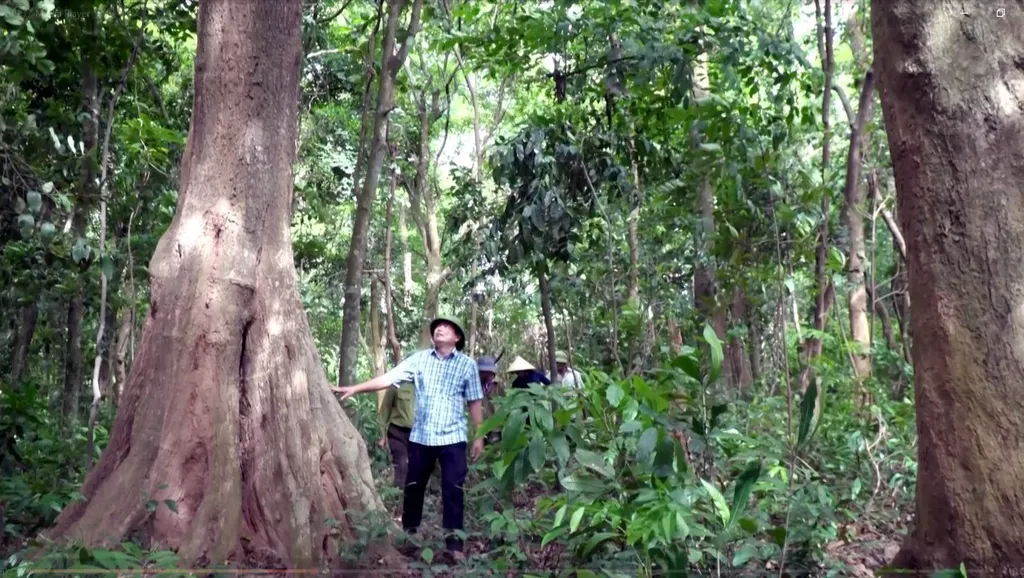 Environment
Environment

 |
| The 5-hectare Lòi Chùa forest in Đồng Thành, Nam Trạch, Bố Trạch District, Quảng Bình Province, is a primeval forest with precious ancient trees, preserved for decades through the joint efforts of local authorities and residents. VNA/VNS Photo |
HÀ NÔI – Developing the carbon credit market is not only a step in the 'green journey', but also an opportunity for countries to reach net zero targets and effectively cope with the increasingly complicated issue of climate change.
The carbon credit market will bring both opportunities and challenges for Việt Nam.
Prime Minister Phạm Minh Chính recently established the National Steering Committee to implement Việt Nam's commitments from the United Nations Climate Change Conference in 2021. He also issued Decision 1658/QĐ-TTg on the National Green Growth Action Plan for the 2021-2030 period, which outlines the main targets for green growth, fulfilling international commitments on climate change and enhancing capacities across related sectors.
By 2025, the Government will establish and pilot a carbon credit trading platform. By 2027, it aims to develop regulations for carbon credit management, establish operational rules for the trading platform, and pilot mechanisms for carbon credit trading and offsetting.
These efforts aim to lay a solid foundation for the carbon credit market, ensuring transparency and effectiveness in transactions while supporting emissions reduction and sustainable development goals.
According to experts, the sooner the carbon market is organised, the more beneficial it will be for Việt Nam, helping us implement green strategies not only domestically but also globally.
The agricultural sector is expected to lead in carbon credit sales, with a target of reaching 80 million tonnes by 2030, mostly focused on forest conservation.
With the legal documents issued, the carbon market is gradually taking shape, increasing compatibility with international carbon credit pricing mechanisms, creating opportunities to link with global and regional carbon markets and enhancing the competitiveness of Vietnamese products in international markets.
The market also serves as a mechanism to promote the development and application of low-emission technologies, moving towards a carbon-neutral economy and encouraging enterprises to invest in technological transitions to reduce carbon emissions during production processes.
Phạm Hồng Quân, Strategic Advisor at the Centre for Environmental Protection and Climate Change Response under the Việt Nam Water Supply and Sewerage Association, told moitruong.net.vn that although legal policies on carbon credits have been slow to develop, it is hoped that this slow but steady approach will ensure that the financial resources related to emission reductions are retained domestically and not lost when participating in the carbon credit mechanism.
Việt Nam can learn from the experiences of building carbon credits in the EU, South Korea and Indonesia, Quân said.
Using lessons learned in these countries, we can come up with more precise and effective implementation solutions, limiting market manipulation, he said.
Transitioning to green production is a trend that many countries are pursuing to meet the goal of zero carbon emissions by 2050.
In other words, the shift to greenification and the application of the circular economy model is an inevitable trend in commercial and investment activities globally.
This shows that to participate in the global market, especially in the EU, Việt Nam and its enterprises must change and adapt, starting with participating in the carbon credit market to avoid being left behind and losing its position in this promising market.
Meanwhile, the carbon credit market is expected to grow rapidly in the near future, not only due to the potential from forests but also in renewable energy sectors like wind and solar power, energy transition projects, waste collection and recycling, agriculture and forestry.
Lack of a mechanism
Tuyên Quang Province is known as one of three localities with the most forest cover in the country, at 65 per cent of its area. The province plants 11,000ha of new forest annually.
With 67,000ha of planted forest, in ten years Tuyên Quang would have nine million carbon credits.
However, due to the lack of a comprehensive legal framework, selling these carbon credits is not straightforward.
The Ministry of Natural Resources and Environment said that Việt Nam does not yet have specific standards to form a domestic carbon credit exchange mechanism, but mainly trades in the international voluntary carbon market.
To date, about 150 programmes and projects have been granted 40.2 million carbon credits traded on the global carbon market.
This is a new and highly significant issue for Việt Nam's net-zero emissions commitment, requiring thorough research and phased implementation to complete the legal framework.
According to Tăng Thế Cường, director of the ministry’s Department of Climate Change, in order to transform forest carbon potential or renewable energy into commodities and generate revenue, it is crucial to quickly develop and enact a complete legal framework to promote investment and operate the carbon credit market.
The current legal regulations do not clarify whether forest carbon credits are considered forest products.
The Law on Forestry defines forest products as "products harvested from forests, including forest plants, forest animals, and other forest organisms, including wood, non-timber forest products, processed wood products, rattan, bamboo, and other forest materials", meaning forest carbon credits are not included.
Because carbon credits are not currently recognised as commodities, transactions in the market cannot be fully legitimate, Cường said.
The Forestry Law and related laws therefore need to be amended and supplemented to recognise carbon sequestered and stored in forests as a type of forest product, or carbon captured from renewable energy sources as a special commodity.
Once carbon credits become a tradable commodity like any other good, ownership disputes will likely arise—not only due to their value but also because they are a unique and intangible commodity, requiring technical verification.
The legal framework must, therefore, also include specific provisions on ownership rights over carbon credits.
Establishing ownership of carbon credits should achieve two objectives: minimising disputes between forest or project owners during renewable energy projects and encouraging investment in and exploitation of carbon credits.
For example, carbon credits from natural forests allocated to households, individuals, communities and non-governmental organisations will belong to those entities for any additional carbon credits generated through forest protection activities, natural regeneration or forest expansion. Meanwhile, carbon credits from planted production forests invested in by forest owners will belong to the forest owners.
Forest carbon in particular, as well as carbon obtained from other renewable energy sources, can only become a commodity once they are verified as credits.
Verification is a process that includes feasibility studies, project development, document verification, credit certification, issuance and transfer.
This specific process has multiple stages that must be conducted by independent organisations, while Việt Nam currently lacks regulations governing the implementation of steps -- or the existing regulations are not consistent with the carbon market and international practices, Cường said.
Skilled workers needed
Last year, Việt Nam successfully transferred more than 10 million carbon credits and earned over US$50 million. This has set a precedent for various organisations, individuals and localities to pay more attention to the high potential of the carbon credit market.
Calculations show that the agricultural sector in Việt Nam could generate 57 million carbon credits annually. If corresponding transactions are realised, it could sell carbon credits valued at around $300 million per year.
Thus, the country needs approximately 150,000 professionals with in-depth knowledge of verification mechanisms, relevant documentation and carbon credit evaluation and registration processes.
Prof. Dr Hoàng Văn Sâm, Head of the International Cooperation Department at Việt Nam Forestry University, noted that the current workforce trained for the carbon credit market in Việt Nam is still quite limited.
This poses a challenge for Việt Nam as it participates in both domestic and global carbon credit markets.
Therefore, developing skilled workers in the carbon credit sector is a crucial factor in ensuring Việt Nam’s effective participation in this market.
To develop a high-quality workforce for the carbon market in Việt Nam, it is necessary to build a strong national team of experts on developing carbon credit projects, calculating emissions and carbon storage, creating reports, establishing standards and negotiating carbon credit transactions. Authorities could also help support businesses in participating in this field, expand international cooperation, and urge universities and training institutions to design curricula and courses relating to the carbon market.
Currently, Việt Nam Forestry University has developed a specialised programme on carbon emissions management, carbon absorption and calculating carbon storage, integrating courses related to climate change, Sâm said.
Meanwhile, Prof. Dr Võ Xuân Vinh, director of the Institute of Business Research at HCM City’s University of Economics, said he believes that if Việt Nam actively engages in the global market and increases the total volume of carbon credits sold, the revenue from this market will be significant.
However, to achieve this, organisations and businesses in this field must prepare a trained workforce now to meet the roadmap for implementing the carbon market, initially in the pilot phase from 2025-2027 and in the official operation phase starting in 2028. VNS




